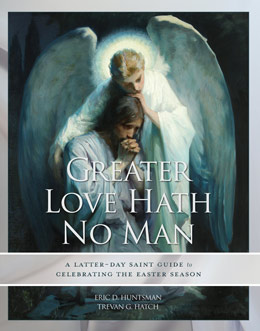Appendix D: Celebrating Holy Week
A Resource Guide for Latter-day Saints
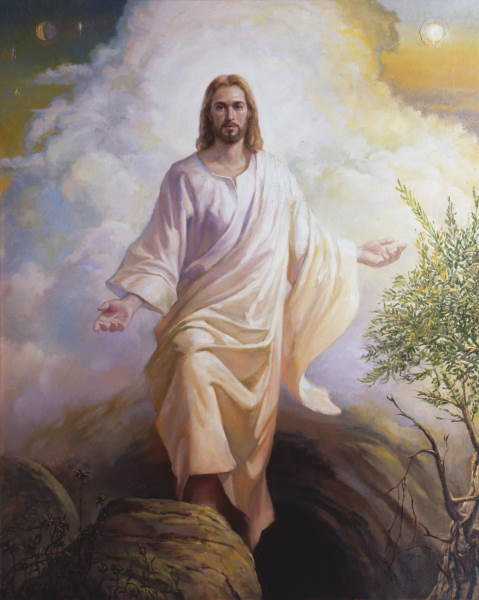 Wilson J. Ong, The Resurrected Christ. Courtesy of Intellectual Reserve, Inc.
Wilson J. Ong, The Resurrected Christ. Courtesy of Intellectual Reserve, Inc.
In the late 1990s, as part of an effort to make Easter as important as Christmas, Eric Huntsman’s family began the process of building new family traditions to prepare for Easter that were based upon the passion narratives and drew upon some traditional Christian traditions.[1] My coauthor Trevan Hatch and I have found that using the holidays to teach our children has also deepened and enriched our own faith. Using more familiar and established Christmas traditions as a guide, in recent years we have adapted them for Easter. The ideas in this appendix—distilled from the discussion of the book as a whole and supplemented with some specific ideas about the music, art, and even food that can enrich Holy Week—have been organized for ease of reference and use. They represent only a beginning, and each family can have its own unique experience “putting Christ back into Easter.”[2]
Before Holy Week
For ideas about preparing for and celebrating Christmas, consider using the four weeks of Advent to study Matthew 1‒2, Luke 1‒2, and the Book of Mormon prophecies about the coming of Jesus such as 1 Nephi 11, Mosiah 3, Alma 7, Helaman 13, and 3 Nephi 1.[3]
Between Christmas and two weeks before Easter, consider reading one of the accounts of Jesus’s ministry (Mark 1‒8; Maty 3‒20; Luke 3‒18; John 1‒10). In the weeks before Palm Sunday, start decorating your home with spring flowers and prints of art depicting the ministry of Jesus, and renew your dedication to your personal prayer life, scripture study, and service to others.
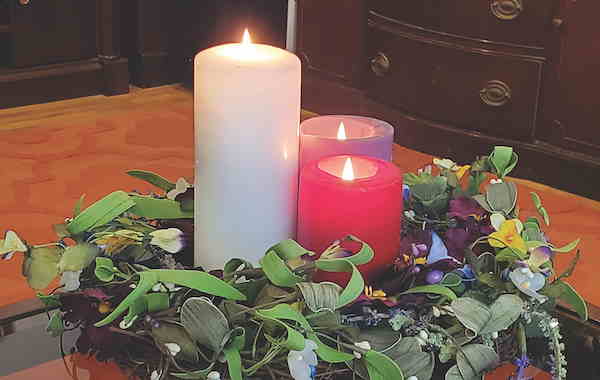 An Easter wreath has three large candles: one each in purple, red, and white. Eric D. Huntsman, used by permission.
An Easter wreath has three large candles: one each in purple, red, and white. Eric D. Huntsman, used by permission.
Some families may even want to borrow from the model provided by the Christmas-season Advent wreath, which is an evergreen wreath with four candles. Each Sunday in the four weeks before Christmas a new candle is lit and a family Christmas devotional is held by its light. Perhaps starting with Lazarus Saturday, the day before Palm Sunday, the family can set up an “Easter wreath,” a flowery wreath with three large candles: a purple one representing that Christ is our king, which can be lit starting on Palm Sunday; a red one representing that he is our priest, added starting on Spy Wednesday; and a white candle, lit Easter morning, which proclaims that Christ came forth alive from the tomb with healing in his wings.
Although this book suggests devotionals starting with Palm Sunday, some families might want to start a week before, using the ideas discussed in chapter 1.
Readings for this week could be as follows:
- Sunday: read Mark 8:22‒26 and discuss the symbolism of the blind man healed in stages.
- Monday: read Mark 8:27‒30 and its parallels in Matt 16:13‒20 and Luke 9:18‒21; read “Pure Testimony” by M. Russell Ballard (Ensign, November 2004, 40‒43) and discuss the elements of a testimony, especially what we need to know about who Jesus is and what he did for us; sing “Testimony” (Hymns, no. 137) or “Search, Ponder, and Pray” (Children’s Songbook, 109).
- Tuesday: read Mark 8:31‒38; discuss what it means to follow Jesus Christ.
- Wednesday: read Mark 9:30‒37; discuss what it means to be a servant and be like a little child.
- Thursday: read Mark 10:32‒45.
- Friday: read Mark 10:46‒52; compare and contrast Bartimaeus and the blind man healed in stages.
- Lazarus Saturday: read John 11:1‒12:11; discuss the raising of Lazarus and why Mary anointed Jesus; sing “My Redeemer Lives” (Hymns, no. 135); make Lazarakia.
- See also the suggestions of Emily Belle Freeman, Celebrating a Christ-Centered Easter, 11‒19.
Inspiring art includes Carl Bloch, Healing the Blind Man and The Raising of Lazarus; vignettes from James Tissot’s The Life of Christ such as The First Shall Be Last, Jesus and the Little Child, Get Thee Behind Me, Satan, The Two Blind Men at Jericho, The Resurrection of Lazarus; Harry Anderson, Christ and the Children; Michael Coleman, Road to Jerusalem; and J. Kirk Richards, Sight Restored.
Palm Sunday
Episodes for Personal Study
- Triumphal Entry (Mark 11:1–10; parallels Matt 21:1–11; Luke 19:28–40; John 12:12–19)
- Jesus’s first lament over Jerusalem (Luke 19:41–44)
- Jesus and the temple (Mark 11:11; parallels Matt 21:12–17; Luke 19:45–48)
Suggestions for Latter-day Saints
- If using an Easter wreath, light the purple candle.
- Read Mark 11:1‒11 and John 12:12‒19 together, perhaps using our reader’s edition on pages 36–38 or our own fresh translation available at http://
erichuntsman.com/ Huntsman_holy_week_scripture_selections_translation.pdf. - Watch the Bible video The Lord’s Triumphal Entry into Jerusalem.
- Read about and then sing “All Glory, Laud, and Honor” (Hymns, no. 69) and perhaps “Hosanna” (Children’s Songbook, 66‒67).
- Watch the music video Tell Me the Stories of Jesus, arranged by Ryan Murphy and performed by the Tabernacle Choir and Orchestra at Temple Square, noting the extra verse about the Triumphal Entry.
- Discuss what it meant for Jesus to have been “the anointed king” and what it will be like when he comes again in glory.
Ideas, Traditions, and Activities for Younger Children
- Charles Colson et al., “Palm Sunday: Praising the King,” Christ in Easter, 1‒16
- Janet and Joe Hales, A Christ-Centered Easter, 6, 18‒19, 26
- Wendee Wilcox Rosborough, The Holy Week for Latter-day Saint Families, 1‒7
Some Inspiring Art
- Carl Bloch, Cleansing the Temple
- Harold Copping, Hosanna to the Son
- James Tissot, The Foal of Bethphage, The Procession on the Mount of Olives, The Procession in the Streets of Jerusalem, and The Merchants Chased from the Temple
- Félix Louis Leullier, Christ’s Triumphal Entry into Jerusalem
- Felix Tafsart, Entry of Jesus in Jerusalem (1896)
- Harry Anderson, Triumphal Entry
- Minerva Teichert, Christ’s Entry into Jerusalem
- Walter Rane, Triumphal Entry of Christ
- Liz Lemon Swindle, Triumphal Entry
Uplifting Music
- “All Glory, Laud, and Honor” (Hymns, no. 69)
- “Hosanna” (Children’s Songbook, 66–67)
- “Tell Me the Stories of Jesus” (Children’s Songbook, 57), adding the additional verse about the Triumphal Entry (see https://
hymnary.org/ text/ tell_me_the_stories_of_jesus_i_love_to) , especially as arranged by Ryan Murphy on Teach Me to Walk in the Light - Brooke Fraser, “Hosanna,” especially as performed by Marantha! Music
Monday
Episodes for Personal Study
- Cursing of the fig tree (Mark 11:12–14; parallel Matt 21:18–19a)
- The cleansing of the temple in Mark (Mark 11:15–19)
- Jesus’s pattern of teaching in the temple (Luke 19:47–48)
- Teachings in the temple: rejection of unbelieving Israel (Mark 11:27–12:12; parallels Matt 21:23–22:15; Luke 20:1–19)
- Jesus and the coming hour (John 12:20–36)
Suggestions for Latter-day Saints
- If using an Easter wreath, again light the purple candle.
- Remembering Jesus as the rightful king from Palm Sunday, sing “Come, O Thou King of Kings” (Hymns, no. 59) or “Beautiful Savior” (Children’s Songbook, 62‒63).
- Read the story of the fig tree in Mark and discuss the importance of bearing good fruit in our lives by following Jesus and keeping his commandments.
- If you did not discuss the cleansing of the temple on Palm Sunday, discuss its symbolism now and talk about the importance of the temple today.
- Sing “We Love Thy House, O God” (Hymns, no. 247) or “I Love to See the Temple” (Children’s Songbook, 95).
- Listen to Handel’s “And He Shall Purify the Sons of Levi,” from Messiah
- Read the parable of the wicked tenants (Matt 21:33–46) and talk about how it foreshadowed what was going to happen to Jesus later that week.
- Read the story of Jesus teaching about the coming hour in John 12:27–36.
- Use the image of Jesus being “lifted up” in the Johannine passion prediction to shift to what the Risen Lord said about holding him up as the light that we shine to the world by following him (3 Nephi 18:16‒24).
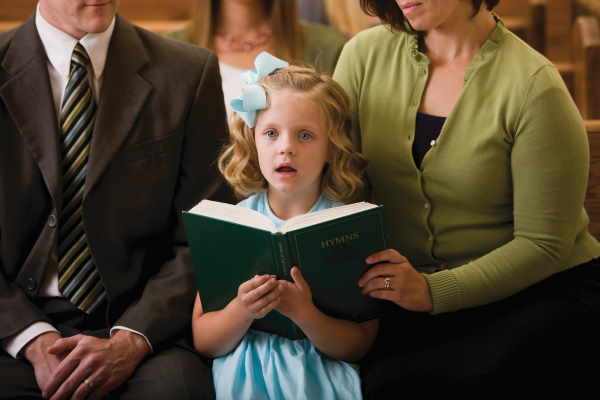 A young girl sings in church while holding a hymnbook. Courtesy of Intellectual Reserve, Inc.
A young girl sings in church while holding a hymnbook. Courtesy of Intellectual Reserve, Inc.
Ideas, Traditions, and Activities for Younger Children
- Charles Colson et al., “Cleansing the Temple,” Christ in Easter, 17‒18
- Janet and Joe Hales, A Christ-Centered Easter, 7
- Wendee Wilcox Rosborough, The Holy Week for Latter-day Saint Families, 9‒15
Some Inspiring Art
- James Tissot, The Accursed Fig Tree, The Merchants Chased from the Temple (again), The Pharisees Question Jesus, The Gentiles Ask to See Jesus, The Voice from on High, Jesus Goes in the Evening to Bethany
Tuesday
Episodes for Personal Study
- Lesson from the withered fig tree (Mark 11:20–26; parallel Matt 21:19b‒22)
- Jesus examined: attempts to catch him in his words (Mark 12:13–37; parallels Matt 22:15–46; Luke 20:20–47)
- Hypocrisy of Jesus’s opponents (Mark 12:38–40; parallels Matt 23:1‒12; Luke 20:45‒47)
- Seven prophetic woes (Matt 23:13‒36)
- The widow’s offering (Mark 12:41–44; parallel Luke 21:1–4)
- Jesus’s second lament over Jerusalem (Matt 23:37‒39)
- The Olivet Discourse (Mark 13:1–38; parallels Matt 24:1–25:46; Luke 21:5–38)
- Summary of Jesus’s teaching (Luke 21:37–38; John 12:37–50)
Suggestions for Latter-day Saints
- If using an Easter wreath, again light the purple candle.
- Using the final lesson from the fig tree, talk about how things are possible with faith and why we should always forgive others.
- Read Luke 20:45–47 and discuss why Jesus was unhappy with the scribes but pleased with the widow’s modest offering.
- Discuss how the questioning of Jesus paralleled the examination of the lambs that were being selected for the Passover that year. How is he the true Lamb of God?
- Listen to Handel’s “Behold the Lamb of God,” from Messiah
- Read Mark 13, the shortest version of the Mount of Olivet Discourse, and discuss why it would have reassured Jesus’s disciples once the Lord had been taken from them. How could it have reassured them that Jesus would still be the rightful king even though he was rejected by his own people?
- Read Jesus’s “parables of preparation” (Matt 24:45‒25:46) and Dallin H. Oaks, “Preparation for the Second Coming,” Ensign, May 2004, 7‒10. What can we do to prepare for the Second Coming?
- Sing “Jehovah, Lord of Heaven and Earth” (Hymns, no. 269).
Ideas, Traditions, and Activities for Younger Children
- Charles Colson et al., “Questioning Jesus,” Christ in Easter, 19‒20
- Janet and Joe Hales, A Christ-Centered Easter, 8, 28‒29
- Wendee Wilcox Rosborough, The Holy Week for Latter-day Saint Families, 17‒23
Some Inspiring Art
- Harold Copping, The Question of the Sadducees
- James Tissot, The Pharisees Question Jesus (again), The Widow’s Mite, The Disciples Admire the Buildings of the Temple, Jerusalem, Jerusalem, The Prophecy of the Destruction of the Temple, and Christ Retreats to the Mountain at Night
- Frans Schwartz, The Wise and Foolish Virgins
- Harry Anderson, The Second Coming of Jesus Christ
- Minerva Teichert, Christ in the Red Robe
- Simon Dewey, All That She Had
- Greg Olsen, O Jerusalem
- Walter Rane, Five of Them Were Wise
- Gary E. Smith, Christ Laments over Jerusalem
- Liz Lemon Swindle, The Widow’s Mites and No Man Knoweth the Hour
Wednesday
Episodes for Personal Study
- The plot to kill Jesus (Mark 14:1–2; parallels Matt 26:1–5; Luke 22:1–2)
- An unnamed woman anoints Jesus (Mark 14:3–9; parallel Matt 26:6–13)
- Judas agrees to betray Jesus (Mark 14:10-11; parallels Matt 26: 14-16; Luke 22:3–6)
Suggestions for Latter-day Saints
- If using an Easter wreath, again light the purple and, starting this night, the red candle.
- Discuss why some people accepted Jesus and others became so hostile to him, working for his death or, in the case of Judas, deciding to betray him. How can we remain faithful to the Lord and share our love for him?
- Read the story of the woman anointing Jesus in either Mark or Matthew. What did this woman understand about why Jesus had come to Jerusalem and what his mission was?
- Sing “O Love That Glorifies the Son” (Hymns, no. 295).
- Read 2 Tim 1:5. How did Lois and Eunice help plant and nurture the faith of Timothy? Share examples of women of Christ in our lives who have strengthened our testimonies.
- Discuss how the priestly, saving mission of the Son in his First Coming, perhaps represented by this anointing, differs from the kingly role that will be particularly manifest in his Second Coming. What kind of king and priest had most Jews at the time of Jesus been expecting and how might this have led them to be disappointed as the Savior’s last week advanced? What kind of king and priest do we expect?
- To be moved by the promises that had been foretold for Jesus’s saving, healing mission, listen to the final four movements of part 1 of Messiah.
Ideas, Traditions, and Activities for Younger Children
- Charles Colson et al., “The Anointing of Jesus,” Christ in Easter, 21‒22
- Janet and Joe Hales, A Christ Centered Easter, 9
- Wendee Wilcox Rosborough, The Holy Week for Latter-day Saint Families, 25‒30
Some Inspiring Art
- Giotto, Payment of Judas, also known as Judas Agrees to Betray Jesus
- Harold Copping, Mary Anointing Jesus
- James Tissot, The Meal in the House of the Pharisee and The Conspiracy of the Jews
- J. Kirk Richards, Alabaster Box
Maundy Thursday
Episodes for Personal Study
- The Last Supper (Mark 14:12–31; parallels Matt 26:17–35; Luke 22:7–38. John 13:1–14:31; compare 1 Cor 11:23‒26)
- The farewell discourses (John 14:1–17:26)
- Jesus at Gethsemane (Mark 14:32–42; parallels Matt 26:36–47; Luke 22:39–46; John 18:1)
- Betrayal and arrest of Jesus (Mark 14:43–52; parallels Matt 26:47–56; Luke 22:47–53; John 18:2–3)
- Jesus before the Jewish authorities (Mark 14:43–65; parallels Matt 26:57–68; Luke 22:54–71; John 18–28)
Suggestions for Latter-day Saints
- If using an Easter wreath, again light the purple and red candles.
- Read Mark’s account of the Last Supper. Discuss the sacrament and its symbolism, sharing how it helps us each week remember the Savior’s sacrifice for us. Sing a favorite sacrament hymn.
- Discuss how Jesus washed the disciples’ feet and commanded that we should love one another. What are ways we can serve and love one another? Perhaps sing “Love One Another” (Hymns, no. 308) together.
- Read Luke’s account of Jesus’s experience in the Garden of Gethsemane. Then, after reading Mosiah 3:7, Alma 7:11–13, and Doctrine and Covenants 19:15–20, bear testimony of how Jesus took upon himself and suffered for our sins, infirmities, sorrows, and other challenges. Sing “Reverently and Meekly Now” (Hymns, no. 185).
- Read Elder Holland’s April 2009 conference address, “None Were with Him,” and discuss how the betrayal, abandonment, false judgment, denial, and abuse of Jesus Christ were all part of his “descending below all things” (Doctrine and Covenants 122:8). How does this increase our confidence in him as our Savior when we realize he understands when we suffer similar rejection?
- If some families would like to hold a Passover Seder or Passover-type meal, we encourage them to do it respectfully and carefully (see our discussion in “Ideas for Latter-day Saints” on pp. 139‒40 of chapter 6 above). Another option would be to hold a Mediterranean style meal using recipes from a resource such as The Food and Feasts of Jesus (Rowman & Littlefield, 2013), and discuss the Last Supper, mentioning that it might have been a Passover meal.
Ideas, Traditions, and Activities for Younger Children
- Charles Colson et al., “The Farewell Feast,” Christ in Easter, 23‒34
- Janet and Joe Hales, A Christ-Centered Easter, 9, 35‒43 (we suggest the Jerusalem Dinner rather than the Passover Activity)
- Wendee Wilcox Rosborough, The Holy Week for Latter-day Saint Families, 33‒39
- If families with children want to mark Passover in some way as part of their commemoration of Maundy Thursday, they might want to watch The Prince of Egypt, The Ten Commandments, or some other movie about the Exodus story and then discuss what the Lord did to deliver his people.
Some Inspiring Art
- Giotto, Arrest of Jesus (also known as Kiss of Judas)
- Anthony van Dyck, The Capture of Christ
- Heinrich Hofmann, The Capture of Christ, Portrait of Christ, the Savior: I Am the Way, the Truth, and the Light, and Christ in Gethsemane
- Carl Bloch, The Last Supper, Christ in Gethsemane, and The Denial of Peter
- Harold Copping, The Last Supper, A Lesson in Humility/
Christ Washing the Feet of the Disciples, and Gethsemane - James Tissot, The Last Supper, The Washing of the Feet, The Protestations of St. Peter (depicts the walk through the Qidron Valley), My Soul Is Sorrowful unto Death, The Grotto of the Agony, Kiss of Judas, The Guards Falling Backwards, The Healing of Malchus, The Tribunal of Annas, Maltreatments in the House of Caiaphas
- Frans Schwartz, Agony in the Garden
- Harry Anderson, Christ in Gethsemane
- Simon Dewey, The Last Supper, In Humility, and O My Father
- Greg Olsen, In Remembrance of Me and No Greater Love
- Del Parson, Jesus Washing the Feet of the Apostles
- Walter Rane, In Remembrance of Me and Not My Will, But Thine
- J. Kirk Richards, The Last Supper, Greatest in the Kingdom, and Gethsemane
- Ary Scheffer, Denial of Peter
- Liz Lemon Swindle, The Last Supper and Gethsemane
- Yongsung Kim, Christ the Servant, Foot Washing, Gethsemane Prayer, and Not My Will But Thine
Uplifting Music
- Bach, St. Matthew Passion, movements 9‒38 for the events of Thursday night
- Beethoven, Christ on the Mount of Olives
- “Reverently and Meekly Now” (Hymns, no. 185)
- “In Memory of the Crucified” (Hymns, no. 190)
- “The Sacrament” (Children’s Songbook, 72)
- “Before I Take the Sacrament” (Children’s Songbook, 73)
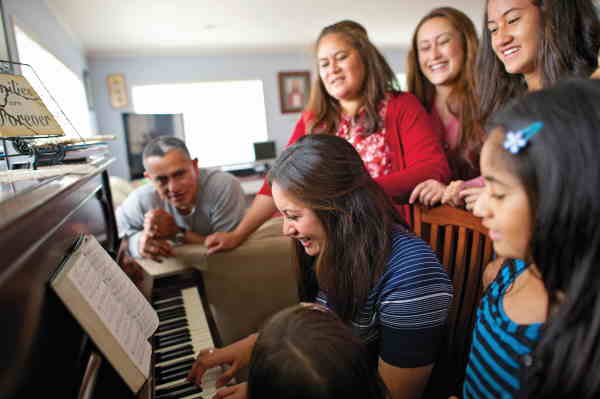 A family gathers around the piano and sings together. Courtesy of Intellectual Reserve, Inc.
A family gathers around the piano and sings together. Courtesy of Intellectual Reserve, Inc.
Good Friday
Episodes for Personal Study
- Jesus in the Hands of the Romans (Mark 15:1–20; parallels Matt 27:1–31; Luke 23:1–25. John 18:29–19:16)
- Jesus Is Crucified; Activities on the Cross (Mark 15:21–32; parallels Matt 27:32–44; Luke 23:26‒43. John 19:17‒24)
- Jesus’s Last Moments and Words (Mark 15:33–36; parallels Matt 27:45–49; Luke 23:44. John 19:25‒29)
- The Death of Jesus (Mark 15:37–41; parallels Matt 27:50–56; Luke 23:45–49. John 19:30‒37)
- The Burial of Jesus (Mark 15:42–47; parallels Matt 27:57–66; Luke 23:50–56. John 19:38–42)
Suggestions for Latter-day Saints
- If using an Easter wreath, again light the purple and red candles.
- Start the day by watching a video about the last day of Jesus’s life, his trial, and crucifixion, such as “Lamb of God.”
- Consider fasting for part of the day, as many Latter-day Saints did in April 2020 at the encouragement of President Nelson as part of our prayers during the COVID-19 pandemic. End the fast with a family meal, which might include the traditional hot cross buns.
- Discuss the trial and abuse of Jesus. How did these experiences constitute part of “descending below all things”?
- Read Isaiah 53:3–4 and discuss what it means that Jesus was “a man of sorrows.” What is the connection between the Lord’s sufferings and how we are falsely judged and badly treated?
- Sing “O Savior, Thou Who Wearest a Crown” (Hymns, no. 197).
- Read one of the Gospel accounts of the crucifixion, such as John 19:17–30.
- Take turns reading the Last Words of Christ (Luke 23:34; 23:43; John 19:26–27; Mark 15:34/
Matt 27:46; John 19:28; Luke 23:46; John 19:30). - Sing one of the sacrament hymns that described Jesus’s death on the cross, such as “Upon the Cross of Calvary” (Hymns, no. 184), “Behold the Great Redeemer Die” (Hymns, no. 191), or “There Is a Green Hill Far Away” (Hymns, no. 194). “He Died That We Might Live Again” (Children’s Songbook, 65) is another good song to consider if there are younger children at home.
- If using an Easter wreath, put out all the candles to symbolize the death of Jesus.
- Read John 3:14–18, John 12:32, and 3 Nephi 27:14–15 and talk about the symbolism of the cross.
- Share testimonies of how Jesus died for our sins.
- Read Emily Belle Freeman’s reflections on Simon, Joseph, and Nicodemus in Celebrating a Christ Centered Easter, 21‒36.
Ideas, Traditions, and Activities for Younger Children
- Charles Colson et al., “The Crucifixion,” Christ in Easter, 35‒47
- Janet and Joe Hales, A Christ Centered Easter, 10‒11
- Wendee Wilcox Rosborough, The Holy Week for Latter-day Saint Families, 31 (recipe for hot cross buns), 41‒47
Some Inspiring Art
- Caravaggio, The Crown of Thorns
- Francisco de Zurbarán, Crucifixion
- Carl Bloch, Christ on the Cross, The Descent from the Cross, and The Burial
- Antonio Ciseri, Ecce Homo
- Harold Copping, Simon of Cyrene Carries Jesus’s Cross and At the Cross
- James Tissot, Jesus before Pilate, First Interview, Jesus before Herod, The Scourging on the Front, The Crowning with Thorns, Agnus Dei: The Scapegoat, Ecce Homo: Behold the Man, Pilate Washes His Hands, Jesus Bearing His Cross, The Procession Nearing Calvary, The Raising of the Cross, The Garments Divided by Cast Lots, Stabat Mater: Woman, Behold Thy Son, “I Thirst”: The Vinegar Given to Jesus, The Strike of the Lance, and The Holy Virgin Receives the Body of Jesus
- Frans Schwartz, The Mocking of Christ
- William Holman Hunt, The Scapegoat
- Harry Anderson, The Crucifixion
- J. Kirk Richards, Ecce Homo, Grey Day at Golgotha, Crucifixion, Though He Were Dead, Yet Shall He Live, and Pieta
- Ron Richmond, Triplus, No. 3 (for blood and water imagery)
- Simon Dewey, Behold the Man
- Yongsung Kim, Holy Crown, The Lamb of God, and Crucifixion
Uplifting Music
- Bach, St. Matthew Passion, movements 39‒68; St. John Passion
- Handel, Messiah, part 2
- “Upon the Cross of Calvary,” “Behold the Great Redeemer Die,” “There Is a Green Hill Far Away,” and “O Savior, Thou Who Wearest a Crown” (Hymns, nos. 184, 191, 194, and 197)
- “He Sent His Son” and “He Died That We Might Live Again” (Children’s Songbook, 34–35 and 65)
- Kathryn Scott, “At the Foot of the Cross (Ashes to Beauty)”
- Sherri Jongeward & Ted Morton, “At the Cross,” especially as performed by Marantha! Music
Holy Saturday
Episodes for Personal Study
- A guard is placed at the tomb (Matt 27:62–66)
- Darkness prevails among the Nephites (3 Nephi 9–10)
- Jesus goes to the spirit world and organizes his work there (1 Pet 3:18–4:6; Doctrine and Covenants 138)
Suggestions for Latter-day Saints
- If using an Easter wreath, leave the purple and red candles unlit.
- Read 3 Nephi 9:14‒22, in which Jesus testifies of his death and resurrection.
- Read Isa 52:7 and 53:10 and then Mosiah 15:10–18. What does it mean that after he has made an offering for sin “he shall see his seed”?
- Read portions of all or some of Doctrine and Covenants 138 and discuss together the activities of Jesus’s spirit during the time that his body was in the tomb.
- Sing “How Beautiful Thy Temples, Lord” (Hymns, no. 288) or “Turn Your Hearts” (Hymns, no. 291).
- Consider attending the temple or doing family history work.
- Return to the fact that during this time Jesus’s body was in the tomb. Perhaps using traditional customs, such as coloring Easter eggs, talk about how the egg has come to be a symbol of the tomb. To prepare for Easter morning, extend the discussion to talk about what happens when the egg hatches.
Ideas, Traditions, and Activities for Younger Children
- Charles Colson et al., “In the Tomb,” Christ in Easter, 49‒52
- Janet and Joe Hales, A Christ-Centered Easter, 11, 24‒25
- Wendee Wilcox Rosborough, The Holy Week for Latter-day Saint Families, 49‒55
Some Inspiring Art
- Andrea di Bonaiuto, Descent of Christ to Limbo
- Fra Angelico, Christ in Limbo
- Andrea Mantegna, Christ’s Descent into Limbo
- Tissot, The Watch over the Tomb
- Robert T. Barrett, Jesus Teaching in the Spirit World
Uplifting Music
- Brahms, German Requiem
- Robert Cundick, The Redeemer
- Mack Wilberg, Requiem
Easter Sunday
Episodes for Personal Study
- The women and the empty tomb (Mark 16:1–8; parallels Matt 28:1–10; Luke 24:1–11)
- Mary Magdalene, Peter, and the Beloved Disciple at the tomb (Luke 24:12; John 20:1–10)
- Mary Magdalene and the Risen Lord (John 20:11–18; Mark 16:9–11)
- Two disciples on the road to Emmaus (Luke 24:13–35; Mark 16:12–13)
- First appearances to the disciples in Jerusalem (Luke 24:36–48; parallel Mark 16:14; John 20:20–25)
- Jesus later appears to Thomas (John 20:26–29)
- The purpose of the Gospel according to John (John 20:30–31)
Suggestions for Latter-day Saints
- If using an Easter wreath, light the purple, red, and finally, the white Easter candle.
- Read one of the resurrection stories, such as Luke 24:1–12. Then bear testimony of the resurrection; sing “Christ the Lord Is Risen Today” (Hymns, no. 200), “He Is Risen” (Hymns, no. 199), or “Jesus Has Risen” (Children’s Songbook, 70); and have family prayer.
- Read or sing C. Austin Miles’s “In the Garden,” which recounts the experience of Mary of Magdala at the empty tomb.
- Talk about the reactions of the different characters to the evidence provided them that first Easter: the stone rolled away, the empty tomb, the witness of angels, and finally appearances of the Risen Lord. How do we react to the news of the resurrection of Jesus? How does our testimony start with small evidences, is reinforced by the witness of others, and finally solidified by personal revelation?
Ideas, Traditions, and Activities for Younger Children
- Traditional Easter activities, such as egg hunts and gathering Easter candy are not out of harmony with the spirit of Easter so long as the spiritual focus comes first and the fun second. Explain some Easter symbolism, such as eggs representing the tomb, the new birth of resurrection, and so forth.
- Carmen Durland Cole, “A Special Easter Treat,” Friend, April 2017, https://
www.churchofjesuschrist.org/ study/ friend/ 2017/ 04/ a-special-easter-treat?lang=eng - Charles Colson et al., “The Resurrection,” Christ in Easter, [53‒63].
- Janet and Joe Hales, A Christ-Centered Easter, 11‒12, 30‒34
- Wendee Wilcox Rosborough, The Holy Week for Latter-day Saint Families, 57‒63; note their “Conference Sunday: When Easter Comes during General Conference,” 65‒71
Some Inspiring Art
- Caravaggio, Supper at Emmaus and The Incredulity of St. Thomas
- Carl Bloch, The Resurrection, Supper at Emmaus, and The Doubting Thomas
- Harold Copping, Woman at the Sepulchre, Mary Magdalene at the Sepulchre, and The Walk to Emmaus
- James Tissot, The Resurrection, Mary Magdalene and the Holy Women at the Tomb, The Disciples Running to the Sepulchre, Noli Me Tangere: Touch Me Not, The Pilgrims of Emmaus on the Road, The Appearance of Christ at the Cenacle, and The Disbelief of St. Thomas
- Frans Schwartz, Christ Showing Himself to the Disciples on the Eve of Easter
- William-Adolphe Bouguereau, Women at the Tomb
- Eugène Burnand, The Disciples Peter and John on the Morning of the Resurrection
- Harry Anderson, Mary and the Resurrected Lord and Behold My Hands and Feet
- Minerva Teichert, Touch Me Not
- Simon Dewey, He Lives
- Greg Olsen, He Is Risen and The Road to Emmaus
- Walter Rane, He Is Not Here
- J. Kirk Richards, Why Weepest Thou? and Road to Emmaus
- Liz Lemon Swindle, He Is Risen, Why Weepest Thou?, Hope, and Emmaus
Uplifting Music
- Handel, Messiah, part 3
- “He Is Risen” and “Christ the Lord Is Risen Today” (Hymns, nos. 199 and 200)
- “Did Jesus Really Live Again?” and “Jesus Has Risen” (Children’s Songbook, 64 and 70)
- Austin Miles, “In the Garden,” especially as arranged by Ryan Murphy, He Is Risen
- Nathan Pacheco, “In Christ Alone,” especially as performed by the artist on Higher
For Further Reading and Reference
Black, Susan Easton, and Liz Lemon Swindle, King of Kings. Vol. 3 of Son of Man. Seymour, CT: Greenwich Workshop Press, 2007.
Colson, Charles et al. Christ in Easter: A Family Celebration of Holy Week. Colorado Springs: NavPress, 1990.
Dewey, Simon. Altus Fine Art, https://
Dolkart, Judith F., David Morgan, and Amy Sitar. James Tissot, The Life of Christ: The Complete 350 Watercolors. Edited by Judith F. Dolkart. New York: Brooklyn Museum/
Freeman, Emily Belle. Celebrating a Christ-Centered Easter: Seven Traditions to Lead Us Closer to Jesus Christ. Salt Lake City: Shadow Mountain, 2015.
Hales, Joe, and Janet Hales. A Christ-Centered Easter: Day-By-Day Activities to Celebrate Easter Week. Salt Lake City: Eagle Gate, 2002.
Olsen, Greg. Wherever He Leads Me: The Greg Olsen Collection. American Fork, UT: Covenant Communications, 2002.
Walter Rane Fine Art Store, https://
Richards, J. Kirk. Fine Art Reproductions, http://
Rosborough, Wendee Wilcox. The Holy Week for Latter-day Saint Families: A Guide for Celebrating Easter. Salt Lake City: Deseret Book, 2016.
Whitaker, Ashlee, et al., Sacred Gifts: The Religious Art of Carl Bloch, Henrich Hofmann, and Franz Schwartz. Provo, UT: Brigham Young University Museum of Art, 2014.
Daniel Zimmer, The Art of Harry Anderson, 10‒14, 188‒97. St. Louis: Illustrated Press, 2018.
Notes
[1] Huntsman, God So Loved the World, 1‒5.
[2] Some of these ideas are also drawn from the seasonal blog that Huntsman developed over the years since the publication of God So Loved the World in 2011. See https://
[3] Eric D. Huntsman, Good Tidings of Great Joy: An Advent Celebration of the Savior’s Birth (Salt Lake City: Deseret Book, 2011).
